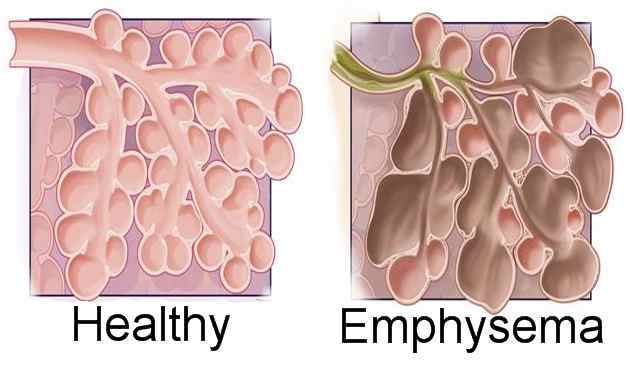
It is a long-term (chronic) lung disease. In emphysema, the tiny air sacs (alveoli) at the end of the airways in the lungs are damaged. When the air sacs are damaged or destroyed, their walls break down and the sacs become larger.
Emphysema
Emphysema is a lung condition that causes shortness of breath. In people with emphysema, the air sacs in the lungs (alveoli) are damaged. Over time, the inner walls of the air sacs weaken and rupture creating larger air spaces instead of many small ones.
Symptoms:
Causes:
· Tobacco smoke
· Marijuana smoke
· Air pollution
· Chemical fumes and dust
Risk factors:
· Smoking. Emphysema is most likely to develop in cigarette smokers, but cigar and pipe smokers also are susceptible.
· Age. Emphysema begin to experience symptoms of the disease between the ages of 40 and 60.
· Exposure to secondhand smoke. Secondhand smoke, also known as passive or environmental tobacco smoke, is smoke that you inadvertently inhale from someone else's cigarette, pipe or cigar.
· Occupational exposure to fumes or dust. You’re more likely to develop emphysemaby dust from grain, wood,cotton or mining productsorbreathing fumes from certain chemicals.
· Exposure to indoor and outdoor pollution. Breathing outdoor pollutants car exhaustas well asindoor pollutantsfumes from heating fuel, for instance increases your risk of emphysema.
Complications:
· Collapsed lung (pneumothorax). This is uncommon but serious when thelung is collapsed.This can be life-threatening in people who have severe emphysema.
· Heart problems. This can cause a condition called cor pulmonale, in which a section of the heart expands and weakens.This disease can increases the arteries pressure that connects the lungsandheart.
· Large holes in the lungs (bullae).
Prevention:
Diagnosis:
Treatment:
· Bronchodilators. These drugs can help relieve coughing, shortness of breath and breathing problems by relaxing constricted airways.
· Corticosteroid drugs.Inhaled steroidswill be inhaled as aerosol sprays may help relieve shortness of breathandreduce inflammation.
· Antibiotics. If you have a bacterial infection, like acute bronchitis or pneumonia, antibiotics are appropriate
Emphysema, chronic lung disease, tiny air sacs, alveoli.